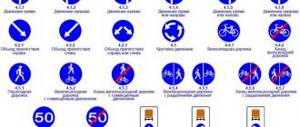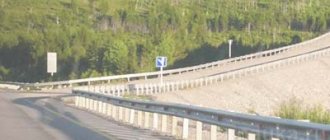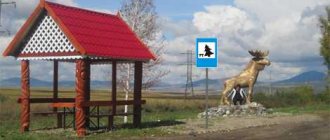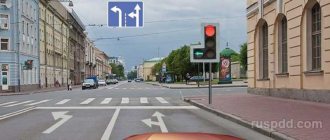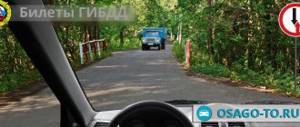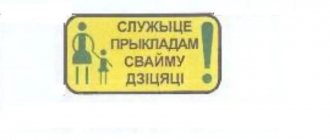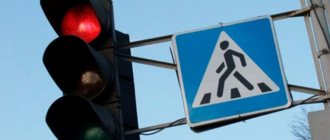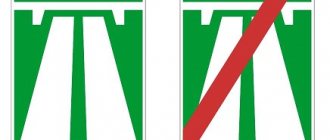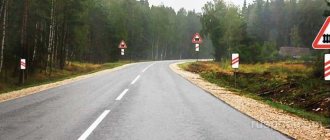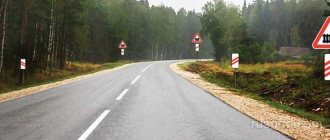You intend to continue straight ahead. Who should give way to?
Please note that this sign prohibits traffic in all other directions.
https://www.youtube.com/watch?v=ytdevru
Features of the straight ahead sign:
- If it is installed at an intersection, then its effect applies only to the intersection of roadways in front of which it is installed.
- If a sign is installed outside an intersection, its effect extends to the nearest intersection. However, it is not prohibited to turn right to enter the adjacent territory.
- Route vehicles have the right not to comply with the requirements of this sign.
Please note that a straight ahead sign can be installed, for example, in a gap in the dividing strip, to prevent vehicles from turning left and turning around.
Please note that violating the requirements of this sign may result in your vehicle ending up on a one-way road and moving there in the opposite direction. Naturally, this is quite dangerous, and such a maneuver is punishable by deprivation of rights.
Driving straight, left or turning is prohibited.
A mandatory sign “Move to the right” is often installed when leaving adjacent areas (parking lots, gas stations) on four or more lane roads.
At the same time, left turns and U-turns are prohibited.
The only direction in which you cannot move is straight.
Let's consider the characteristic features of all of the above prescriptive signs (4.1.1 – 4.1.6):
- They apply only to the intersection of roadways in front of which they are installed.
- They do not apply to public transport.
- Signs may use other arrow configurations to suit a specific roadway intersection.
1. If the driver simply violates the requirement of a road sign, then he will be fined in the amount of 500 rubles.
For example, when leaving a yard on a two-lane road without markings, a “Move to the left” sign is installed, and the driver turns right.
2. If the driver turns left or makes a U-turn in a place where this is prohibited by one of the above signs, he will be fined 1,000 - 1,500 rubles.
For example, this can happen when making a U-turn at an intersection where there is a “Move to the right” sign.
3. If the driver, having violated the requirements of any of the above signs, ends up in the lane for fixed-route vehicles, then he will be fined 1,500 rubles (3,000 rubles in Moscow and St. Petersburg).
4. If, after violating a road sign, you enter a one-way road, then the driver will either be fined in the amount of 5,000 rubles, or he will be deprived of his driver’s license for a period of 4 to 6 months.
A complete list of fines for violating traffic rules can be found on the traffic police fine table for 2021 page.
| 1. | In front of the sign. |
| 2. | At the intersection in front of the broken marking line. |
| 3. | Before the intersection at the marking line. |
| 4. | Any place at the driver's discretion. |
https://www.youtube.com/watch?v=ytpolicyandsafetyru
Marking 1.13 (in the form of a line of triangles) is applied across the lane and indicates the place where you should stop if necessary, fulfilling the requirement of the “Give Way” sign and giving priority to vehicles moving along the road being crossed. The correct answer is: Before the intersection at the marking line.
| 1. | All vehicles. |
| 2. | Only for cars and buses. |
| 3. | Passenger car only. |
Since you are approaching the intersection along a secondary road (signs “Give way” and “Direction of the main road”), you only need to give way to buses and cars. But in relation to the motorcycle, you have an advantage according to the rules for passing intersections of equivalent roads and, since you are on the right side of it.
| 1. | Only by bus. |
| 2. | Passenger car only. |
| 3. | Both vehicles. |
Since you are approaching an intersection of unequal roads on a secondary road (signs “Give Way” and “Main Road Direction”), you must give way to both vehicles moving on the main road, regardless of the direction of their further movement. This rule is universal and applies to intersections of any configuration.
| 1. | Only bus and motorcycle. |
| 2. | Only for cars and buses. |
| 3. | All vehicles. |
In this case, you must give way to a motorcycle and a bus, because they are on the main road (signs “Give Way” and “Main Road Direction”), and to a passenger car located, like you, on a secondary road, since it is for you are an “obstacle on the right” and you pass with him according to the rules for driving through intersections of equivalent roads.
| 1. | Both vehicles. |
| 2. | Passenger car only. |
| 3. | Only by bus. |
This is an intersection of unequal roads (signs “Give Way” and “Main Road Direction”). The main road at the intersection changes direction. You are approaching the intersection on a secondary road and, therefore, are required to give way to both vehicles moving on the main road, regardless of the direction of their movement.
| 1. | Yes. |
| 2. | Yes, but without interfering with the truck. |
| 3. | No. |
The “Give Way” sign obliges you to give way to a truck at a given intersection of unequal roads, without requiring you to stop before the intersection. Since the truck is moving in the left lane, which is further away from you, you can proceed to turn right. However, during the entire maneuver you must not interfere with the movement of the truck.
| 1. | Only A. |
| 2. | Only B. |
| 3. | Only A and B. |
| 4. | All. |
| Sign A “Adjacent to a secondary road” refers to priority signs and informs you that you are on the main road and at the intersection have priority over vehicles approaching from the left. |
| Signs B “Give way” and “Direction of the main road” inform about the need at the intersection to give way to vehicles approaching on the main road (the direction of the main road is shown on sign 8.13) both from the left and from the opposite direction. |
| Sign B “Exiting onto a road with a lane for route vehicles” does not establish the order of passage through the intersection and only informs about entering a road where the oncoming lane is allocated for route vehicles. |
The correct answer is Only B.
| 1. | Passenger car only. |
| 2. | Only for a truck. |
| 3. | Both vehicles. |
Since you are on a secondary road (signs “Give way” and “Direction of the main road”), you can drive through an intersection of unequal roads, giving way to both vehicles that are moving on the main road.
The order of passage through intersections of unequal roads does not depend on their configuration. Therefore, when you are on a secondary road (signs “Give way” and “Direction of the main road”), you must give way to both vehicles moving along the main road.
| 1. | Yes. |
| 2. | Yes, after the truck starts turning. |
| 3. | No. |
A “Give Way” sign requires you to yield the right of way to a truck approaching an unequal intersection on the road being crossed. Since Yield does not require you to stop, you can begin turning right once you are sure the truck is actually turning left. At the same time, during the entire maneuver you should not interfere with its movement.
| 1. | Only by bus. |
| 2. | Only for a truck. |
| 3. | Both vehicles. |
https://www.youtube.com/watch?v=https:accounts.google.comServiceLogin
Since there is a “Give way” sign in front of the intersection, when moving along a secondary road, you must, guided by the rules for driving at intersections of unequal roads, give way to both vehicles.
| 1. | Passenger car only. |
| 2. | Only for buses and cars. |
| 3. | All vehicles. |
Since you are approaching the intersection on a secondary road (signs “Give way” and “Direction of the main road”), you must give way to buses and cars. In relation to the motorcycle, you have an advantage, since both are on secondary roads.
| 1. | Only for a motorcycle. |
| 2. | Only for motorcycles and cars. |
| 3. | Only bus and motorcycle. |
| 4. | All vehicles. |
At this intersection of unequal roads (signs "Give Way" and "Main Road Direction") you must give way to a motorcycle and a bus as they move along the main road. You should also give way to a passenger car approaching from the right, when passing which you must follow the rules for driving through intersections of equivalent roads.
As a rule, prescriptive signs are made in the shape of a circle. Pictograms are most often depicted on a dark blue background. They allow traffic: “arrows” before crossing roads, a sign indicating the entrance to a roundabout, signs indicating pedestrian or bicycle paths.
Prescriptive signs do not impose restrictions, but, on the contrary, require the performance of a specific maneuver: they show the direction, speed and type of transport that can continue moving.
Penalties for violating the traffic lane sign
Penalties for violating the requirements of these signs directly depend on what kind of traffic violation will follow in connection with non-compliance with the instructions.
Table of fines for violating the “Driving in lanes” sign:
| Type of offense | Amount of penalties |
| Driving along the median | Warning or 500 rub. |
| Changing lanes without giving a light signal | Warning or 500 rub. |
| Turning or turning around in violation of the requirements | From 1000 to 1500 rub. |
| Failure to comply with the requirements regarding the inadmissibility of certain types of transport on the lane (in the constituent entities of the Russian Federation, except for cities of federal significance) | 500 rub. |
| Failure to comply with requirements regarding the inadmissibility of certain types of transport on the highway (in cities of federal significance) | 5000 rub. |
| Ignoring a sign resulting in driving into oncoming traffic onto a one-way road | 5000 rub. or withdrawal of the certificate for a period of 4 months. up to six months |
| Repeated commission of a previous offense | Deprivation of rights for 1 year (in case of automatic recording by a video camera - 5000 rubles) |
| Ignoring an information sign resulting in driving into a public transport lane | 3000 rub. - in Moscow and St. Petersburg, in other regions - 1500 rubles. |
| Driving on a bicycle or pedestrian path in defiance of a lane sign | 2000 rub. |
| Overtaking in the oncoming lane | 5000 rub. or deprivation from 4 to 6 months. |
What do these road signs inform you about?
| 1. | About approaching an intersection where there is a “Give Way” sign. |
| 2. | About approaching an intersection where there is a sign “Driving without stopping is prohibited.” |
| 3. | About approaching customs. |
The “Give Way” sign in combination with the “Distance to Object” sign informs you that in 250 m there is an intersection with limited visibility of the road being crossed, in front of which there is a STOP sign.
| 1. | Yes, if there is no approaching train. |
| 2. | Yes. |
| 3. | No. |
In such a situation, when the vehicles behind the crossing force you to stop at the crossing, the Rules prohibit entry to it even in the absence of an approaching train.
You intend to turn left. Can you start turning?
| 1. | Yes, but without interfering with the truck. |
| 2. | Yes. |
| 3. | No. |
At the intersection of unequal roads, the Rules do not prohibit you from turning left at the same time as a truck, since when passing on the right sides, the trajectories of the vehicles do not intersect. However, while on a secondary road (signs and ), you must make sure, firstly, that the truck has actually begun to turn left and, secondly, that, taking into account the dimensions of the vehicles and the width of the roadway, you will not interfere with it during the turn.
| 1. | Yes, if overtaking is completed before the intersection. |
| 2. | Yes. |
| 3. | No. |
You are approaching an uncontrolled intersection on a minor road (Give Way sign). At uncontrolled intersections, overtaking is prohibited when driving on a road that is not the main one. Therefore, in this situation, overtaking a truck can only begin if it is completed before the intersection.
Sign to avoid obstacles on the right
Passing on the left is prohibited.
Passing on the right is prohibited.
Signs 4.2.1-4.2.3 are usually installed at the beginning of the fence along the axis of the roadway, at the beginning of the dividing strip, as well as in the presence of other obstacles on the roadway. For example, when carrying out repair work on the road. These signs can be installed on special stands.
I would like to note that violation of the requirements of signs 4.2.1-4.2.3 may result in the car ending up in the oncoming lane. Currently, for such a violation, the driver can be deprived of his license for a period of 4 to 6 months.
https://www.youtube.com/watch?v=https:uwG5i6jXnsg
The next article in the “Traffic Signs” series will talk about several new mandatory traffic signs.
Good luck on the roads!
Categories of signs
There are several signs that determine the direction of traffic flow. Such pointers can be divided into several separate categories:
- The first category of road signs is most often installed on certain sections of the highway, in which there is an uneven number of rows for moving in different directions.
- The second category of signs are installed on sections of the road with one row to indicate the direction of traffic flow.
- The third category is “Turn on Lanes” signs. This sign is installed at or in front of road intersections to indicate the turn for each lane.
- The fourth category is “Beginning and ending of a row.”
- The fifth category of signs is the so-called “Lane Driving Modes”. This type can be divided into several subcategories: signs designed to limit the movement of certain types of vehicles, signs to indicate the speed limit.
In combination with some signs, a sign may be installed that prohibits making a U-turn at an intersection. The effect of this sign applies to the entire intersection, and not to one intersection of the roadway.
Most often, such a sign is installed at intersections of highways, where turning around may be unsafe for vehicles moving in the opposite direction and for other traffic participants.
